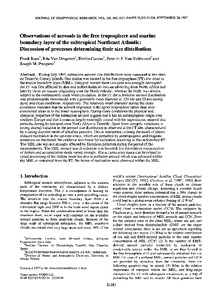Por favor, use este identificador para citar o enlazar este ítem:
http://hdl.handle.net/20.500.11765/2219
Observations of aerosols in the free troposphere and marine boundary layer of the subtropical Northeast Atlantic: discussion of processes determining their size distribution
Registro completo de metadatos
| Campo DC | Valor | Lengua/Idioma |
|---|---|---|
| dc.contributor.author | Raes, Frank | es_ES |
| dc.contributor.author | Van Dingenen, Rita | es_ES |
| dc.contributor.author | Cuevas Agulló, Emilio | es_ES |
| dc.contributor.author | Velthoven, Peter F. J. van | es_ES |
| dc.contributor.author | Prospero, Joseph M. | es_ES |
| dc.date.accessioned | 2016-05-03T07:35:28Z | - |
| dc.date.available | 2016-05-03T07:35:28Z | - |
| dc.date.issued | 1997 | - |
| dc.identifier.citation | Journal of Geophysical Research: Atmospheres. 1997, 102(D17), p. 21315–21328 | es_ES |
| dc.identifier.issn | 2169-897X | - |
| dc.identifier.issn | 2169-8996 | - |
| dc.identifier.uri | http://hdl.handle.net/20.500.11765/2219 | - |
| dc.description.abstract | During July 1994, submicron aerosol size distributions were measured at two sites on Tenerife, Canary Islands. One station was located in the free troposphere (FT), the other in the marine boundary layer (MBL). Transport toward these two sites was strongly decoupled: the FT was first affected by dust and sulfate-laden air masses advecting from North Africa and later by clean air masses originating over the North Atlantic, whereas the MBL was always subject to the northeasterly trade wind circulation. In the FT the submicron aerosol distribution was predominantly monomodal with a geometric mean diameter of 120 nm and 55 nm during dusty and clean conditions, respectively. The relatively small diameter during the clean conditions indicates that the aerosol originated in the upper troposphere rather than over continental areas or in the lower stratosphere. During dusty conditions the physical and chemical properties of the submicron aerosol suggest that it has an anthropogenic origin over southern Europe and that it remains largely externally mixed with the supermicron mineral dust particles during its transport over North Africa to Tenerife. Apart from synoptic variations, a strong diurnal variation in the aerosol size distribution is observed at the FT site, characterized by a strong daytime mode of ultrafine particles. This is interpreted as being the result of photoinduced nucleation in the upslope winds, which are perturbed by anthropogenic and biogenic emissions on the island. No evidence was found for nucleation occurring in the undisturbed FT. The MBL site was not strongly affected by European pollution during the period of the measurements. The MBL aerosol size distribution was bimodal, but the relative concentration of Aitken and accumulation mode varied strongly. The accumulation mode can be related to cloud processing of the Aitken mode but also to pollution aerosol which was advected within the MBL or entrained from the FT. No bursts of nucleation were observed within the MBL. | es_ES |
| dc.format | application/pdf | - |
| dc.language.iso | eng | es_ES |
| dc.publisher | American Geophysical Union | es_ES |
| dc.subject | Aerosols | es_ES |
| dc.subject | Free troposphere | es_ES |
| dc.subject | Marine boundary layer | es_ES |
| dc.title | Observations of aerosols in the free troposphere and marine boundary layer of the subtropical Northeast Atlantic: discussion of processes determining their size distribution | es_ES |
| dc.type | info:eu-repo/semantics/article | es_ES |
| dc.relation.publisherversion | https://dx.doi.org/10.1029/97JD01122 | es_ES |
| dc.rights.accessRights | info:eu-repo/semantics/openAccess | es_ES |
| Colecciones: | Artículos científicos 1995-1999 | |
Ficheros en este ítem:
| Fichero | Descripción | Tamaño | Formato | ||
|---|---|---|---|---|---|
| Raes_1997_JGRSE.pdf | 1,52 MB | Adobe PDF |  Visualizar/Abrir |
Los ítems de Arcimis están protegidos por una Licencia Creative Commons, salvo que se indique lo contrario.





